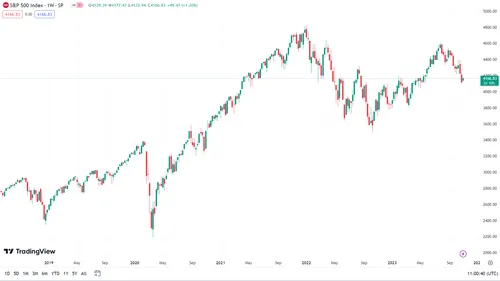Our partner, XM, lets you access a free demo account to apply your knowledge.
No hidden costs, no tricks.

The global financial markets go through cycles of booms and busts over time. Periods of rapid growth are followed by market pullbacks and corrections.
When a market correction sinks the market by at least 20%, meaning that asset prices across the board keep falling, this is thought to be a bear market.
It must be noted that bear markets are typically much shorter than bull markets, as they often trigger governments to respond and address the issues before the bear market turns into a nationwide recession and causes more hardships in otherwise unaffected areas of the economy.
To evaluate bear markets, it is helpful to look at the performance of the S&P 500 to see how the benchmark equities index reacts to market pullbacks and pessimistic sentiment.
When investor confidence is down, even the stocks with strong fundamentals and profitability struggle for price growth, as investors are not expecting a bullish run in the short-term and are refraining from speculative investments.
Another characteristic of bear markets is the shifting focus between asset classes, which is largely tied to inflation and interest rate increases during a bear market.
If you are a beginner investor and would like to know more about bear markets, this investfox guide is for you.
Bear markets are characterized by distinctive asset performance and pricing. Traders can follow these factors to determine whether they are in a bear market or not and how likely a bear market is to occur on the horizon.
Some important characteristics of bear markets include:
Bear markets can vary in duration and intensity, with some being short and shallow, while others are prolonged and severe.
It must be noted that bear markets are considerably different from bull markets, not just in the direction of asset prices, but in duration, severity, and speed as well.
When investors are in panic, mass sell-offs can ensue, leading to dramatic drops in asset prices.
Such steep declines can spill over into other sectors of the economy, causing a nationwide recession.
Governments take these declines into consideration and seek to stimulate the economy wherever possible to avoid economic downturns, which increases unemployment, destroys wealth and leads to instability in the economy.
A good example of a short bear market has been the year 2022, when most stocks declined considerably, with talks of recessions dominated the media conversations and investor sentiment showed signs of considerable decline.
For this reason, bear markets are closely monitored and governments are alarmed of a potential recession when asset prices drop too low.
Looking at the S&P 500 price chart, we can see the sudden drop in 2022, which shed billions of dollars in shareholder value across the board:

As we can see on the chart, the S&P 500 declined considerably in 2022, before rebounding by the start of 2023. While the trend was much shorter than the bull market that kicked off in 2008, the sheer degree of price decline can qualify the year 2022 as a bear market.
Our partner, XM, lets you access a free demo account to apply your knowledge.
No hidden costs, no tricks.
Bear markets are marked by a sustained decline in asset prices, typically 20% or more, driven by pessimism and economic challenges. Investors sell stocks due to fear and uncertainty, causing a self-reinforcing cycle of declining prices.
Bear markets can be dangerous for investors, as they often lead to significant losses in asset values. Investors who sell in a panic or lack a diversified portfolio may experience substantial financial setbacks.
After a bear market ends, a recovery phase begins, marked by a sustained upturn in asset prices. Investor confidence gradually returns as economic conditions improve. Bear markets are typically followed by bull markets, characterized by rising prices and optimism.